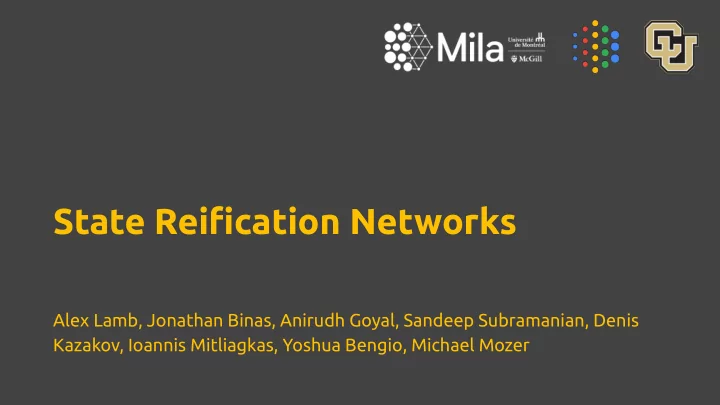

State Reification Networks Alex Lamb, Jonathan Binas, Anirudh Goyal, Sandeep Subramanian, Denis Kazakov, Ioannis Mitliagkas, Yoshua Bengio, Michael Mozer
Reification in Cognitive Psychology ● Human visual perception involves interpreting scenes that can be noisy, missing features, or ambiguous. ● Reification refers to the fact that the output of perception is a coherent whole, not the raw features.
Reification in Machine Learning ● Models are more useful for prediction than are the raw data. If that’s true for real-world data, might it ● also be true for data that originate from within the model (i.e., its hidden states)? Reification = exchanging inputs with ● ? points that are likely under the model. Clean (similar to training)
Examples of Reification in Machine Learning ● Batch normalization Performs extremely well, yet only considers 1st and 2nd ○ moments ● Radial Basis Function Networks Projects to “prototypes” around each class ➛ very restrictive ○ ● Generative Classifiers Requires extremely strong generative model, poor practical ○ performance
State Reification Input Space
State Reification ● Hidden states can have simpler statistical structure Input Space Hidden Space
Explicit Frameworks for State Reification ● Two frameworks for different model types Denoising Autoencoder (CNNs and RNNs) ○ Attractor Networks (RNNs) ○
Task Overview Architecture State reification Task CNN Denoising autoencoder Generalization and adversarial robustness RNN Attractor net Parity Majority Function Reber Grammar Sequence Symmetry RNN Denoising autoencoder Accumulating errors with free running sequence generation
Task Overview Architecture State reification Task CNN Denoising autoencoder Generalization and adversarial robustness RNN Attractor net Parity Majority Function Reber Grammar Sequence Symmetry RNN Denoising autoencoder Accumulating errors with free running sequence generation
Denoising Autoencoder
Denoising Autoencoder Learned denoising function. (Alain and Bengio, 2012)
Adversarial Robustness Setup ● Projected Gradient Descent Attack (PGD): Train with adversarial examples and DAE reconstruction loss: ●
Adversarial Robustness → Improving Generalization ● Improves generalization in adversarial robustness from training set to test set.
Adversarial Robustness - some analysis ● Reconstruction error is larger on adversarial examples. ● When the autoencoder is in the hidden states, this detection doesn’t require a high-capacity autoencoder.
Experiments Architecture State reification Task CNN Denoising autoencoder Generalization and adversarial robustness RNN Attractor net Parity Majority Function Reber Grammar Sequence Symmetry RNN Denoising autoencoder Accumulating errors with free running sequence generation
Attractor Net ✔ Network whose dynamics can be characterized as moving downhill in energy, arriving at stable point. state space
Attractor Net Dynamics
Attractor Net Training: Denoising by Convergent Dynamics
Attractor Nets in RNNs ✔ In an imperfectly trained RNN, feedback at each step can inject noise ○ Noise can amplify over time ✔ Suppose we could ‘clean up’ the representation at each step to reduce that noise? ○ May lead to better learning and generalization
State-Reified RNN within across sequence sequence step steps
State-Reified RNN … …
State-Reified RNN … … … … … … … …
Training task loss reconstruction … … … … … … … … loss noise noise noise
Parity Task ○ 10 element sequences 1001000101 ➞ 0 0010101011 ➞ 1 ○ Training on 256 sequences novel sequences noisy sequences
Majority Function 01001000101 ➞ 0 ○ 100 sequences, length 11-29 11010111011 ➞ 1 Novel sequences Noisy sequences
Reber Grammar ○ Grammatical or not? ○ Vary training set size BTTXPVE ➞ 0 BPTTVPSE ➞ 1
Symmetry ACAFBXBFACA ➞ 1 ○ Is sequence symmetric? ACAFBXBFABA ➞ 0 ○ 5 symbols, filler, 5 symbols Filler length 1 Filler length 10
Experiments Architecture State reification Task CNN Denoising autoencoder Generalization and adversarial robustness RNN Attractor net Parity Majority Function Reber Grammar Sequence Symmetry RNN Denoising autoencoder Accumulating errors with free running sequence generation
Identifying Failures in Teacher Forcing ● Train LSTM on character-level Text8 dataset for language modeling. ● Train a denoising autoencoder on the hidden states while doing teacher forcing Sampling Steps Reconstruction Error Ratio 0 1.00 50 1.03 180 1.12 300 1.34
Open Problems ● How well does state reification scale to harder tasks and larger datasets? ● Denoising autoencoders with quadratic loss may not be ideal for reification. Maybe GANs or better generative models could help? ○ Thinking about how the states are changed to make ● reification easier (are these changes ideal or not)? ○ For example, reification might be made easier by having more compressed representations.
Questions? ● Can also email questions to any of the authors!
Recommend
More recommend